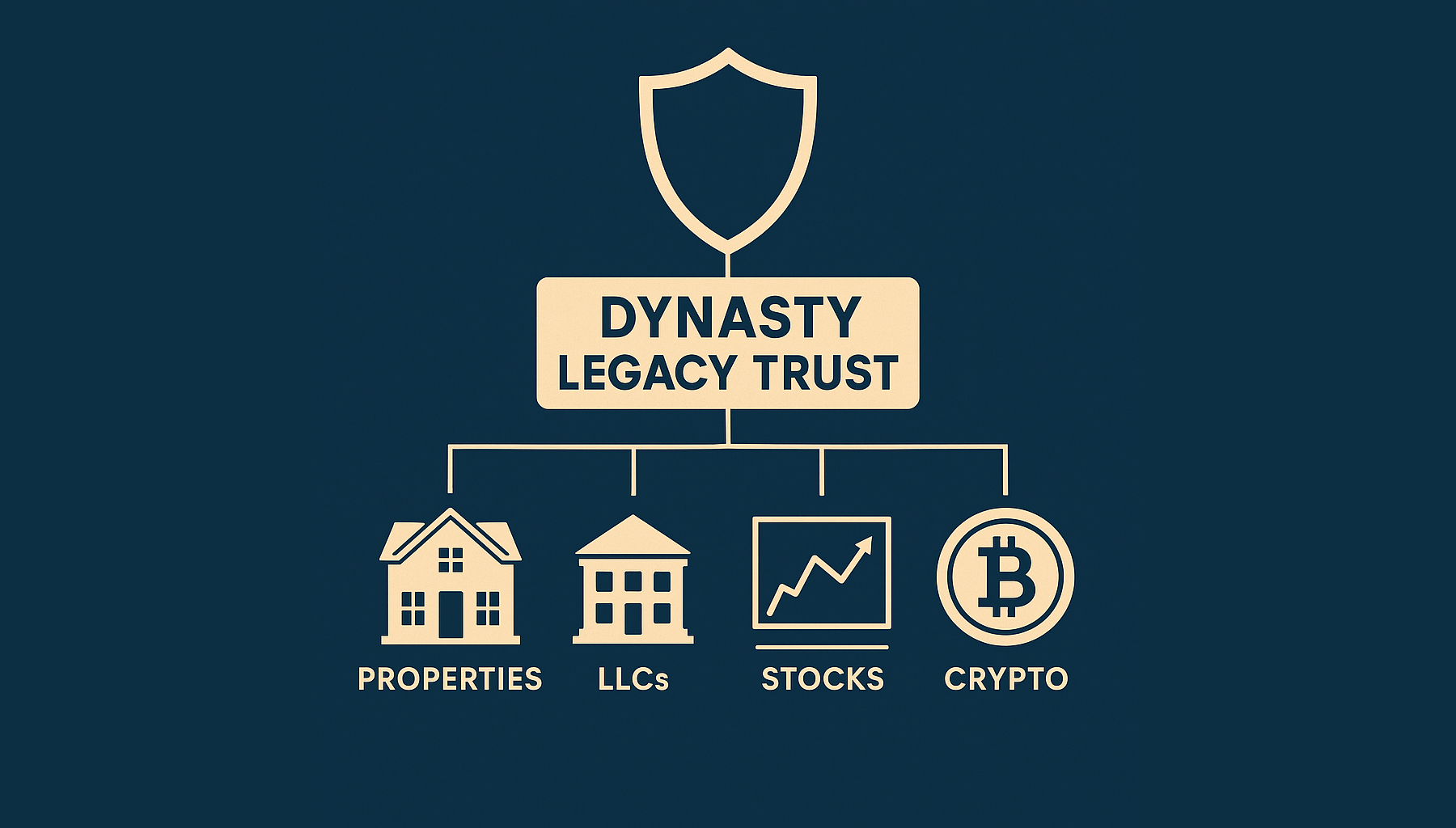Creating a Dynasty Legacy Trust is a powerful way to preserve wealth across generations while protecting assets from taxes, creditors, and probate. Here’s a clear action plan to structure and implement your trust, including the ownership of properties, LLCs, stocks, and crypto.
🔑 Phase 1: Define Your Legacy and Goals
✅ Step 1: Clarify Purpose and Goals
-
Wealth Preservation: Avoid estate taxes, protect from lawsuits/divorce.
-
Multi-Generational Impact: Set rules for distributions and wealth management.
-
Privacy: Keep ownership of assets out of public view.
-
Philanthropy (optional): Include charitable giving strategies.
✅ Step 2: Identify Assets to Transfer
List the current and expected assets:
-
Real Estate (personal, rental, commercial)
-
LLCs (operating or holding companies)
-
Stocks and brokerage accounts
-
Cryptocurrencies and NFTs
-
Cash reserves and future earnings (e.g., royalties, IP)
🏛 Phase 2: Design the Trust Structure
✅ Step 3: Choose the Right Type of Trust
-
Dynasty Trust (Irrevocable): Lasts for multiple generations; asset protection.
-
Use Grantor Trust status if you want to pay the taxes yourself (maximizes trust growth).
✅ Step 4: Select Jurisdiction
Choose a state with strong Dynasty Trust laws:
-
South Dakota (most favorable)
-
Nevada
-
Alaska
-
Delaware
These states allow long durations (some indefinite), strong privacy laws, and low/no state income tax.
✅ Step 5: Choose Key Roles
-
Grantor: You
-
Trustee: Choose a professional, institutional, or family member (you can have a protector oversee them)
-
Beneficiaries: Children, grandchildren, charities
-
Trust Protector: Can replace trustees, fix errors, adjust terms over time
📑 Phase 3: Legal Setup
✅ Step 6: Hire a Trust & Estate Attorney
-
Preferably licensed in a dynasty-trust-friendly state.
-
Familiar with asset protection and advanced wealth planning.
-
Coordinate with your CPA, financial advisor, and business attorney.
✅ Step 7: Draft and Fund the Trust
-
Create the Trust Agreement (core legal document)
-
Establish LLC Holding Companies if needed:
-
Real estate and business assets should be held in LLCs for liability protection
-
The LLCs are then owned by the Trust
-
-
Retitle Assets into the Trust:
-
Real estate: Transfer deeds
-
LLCs: Update Operating Agreements, ownership shares
-
Brokerage accounts: Use TOD (transfer on death) or direct ownership
-
Crypto: Use multi-sig wallets or hardware wallets. Share private key access with the trustee via legal documentation
-
✅ Step 8: Include an Investment Policy Statement (IPS)
-
Define how assets are to be managed (e.g., real estate income, crypto rebalancing).
-
Include instructions for future trustees and protectors.
🧾 Phase 4: Compliance & Maintenance
✅ Step 9: Tax Reporting & Accounting
-
Annual Trust Tax Returns (Form 1041 or state equivalent)
-
Ensure LLCs are compliant with annual filings
-
Track basis and capital gains for inherited assets
-
Coordinate with CPA for generation-skipping transfer (GST) tax planning
✅ Step 10: Periodic Reviews
-
Update trust terms with major life changes (births, deaths, marriages)
-
Review every 1–2 years with your estate attorney
-
Audit digital access, wallet security, and beneficiary info
🛡 Phase 5: Asset Protection and Succession
✅ Step 11: Add Layered Protection
-
Use LLCs in series for real estate
-
Insure all properties and businesses
-
Store crypto seed phrases securely and redundantly
-
Consider a Private Trust Company to manage complex family trusts
✅ Step 12: Educate Heirs
-
Prepare a family legacy statement
-
Set expectations for stewardship vs. entitlement
-
Consider creating a family bank inside the trust (for funding ventures, education, etc.)
🧭 Timeline Overview (90-Day Initial Setup Plan)
| Week | Tasks |
|---|---|
| 1–2 | Define goals, list assets, pick trust jurisdiction |
| 3–4 | Hire attorney, design trust and LLC structure |
| 5–6 | Draft trust, form LLCs, open trust accounts |
| 7–8 | Transfer ownership of real estate, stocks, crypto |
| 9–10 | Implement crypto key security and wallet strategy |
| 11–12 | Finalize documentation, tax plan, and ongoing governance |
📊 KPIs to Track Annually
-
Trust growth rate (assets under management)
-
Distribution schedule vs. income earned
-
Legal and tax compliance deadlines
-
Beneficiary engagement (e.g., education, contributions)
-
Asset performance (stocks, real estate, crypto ROI)
